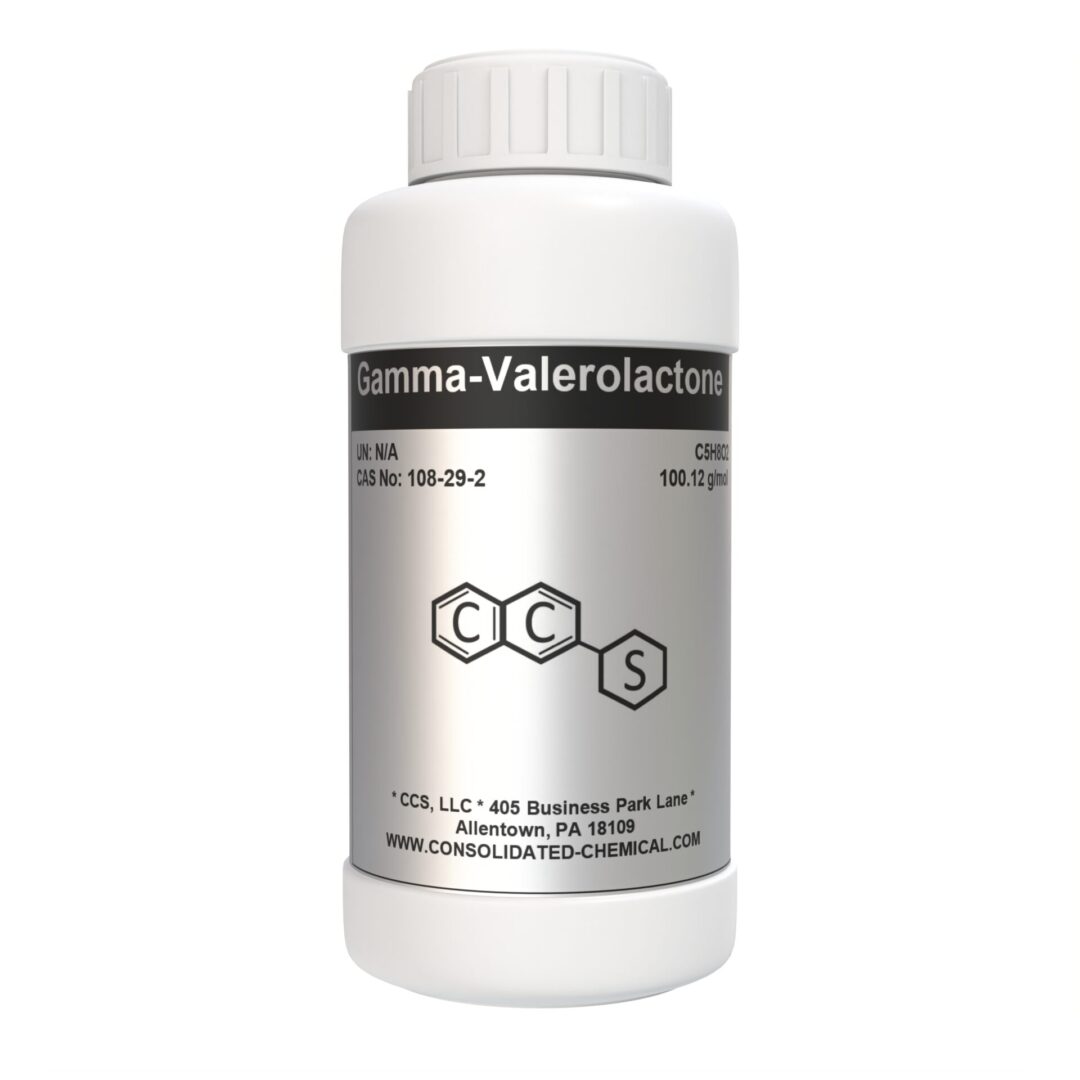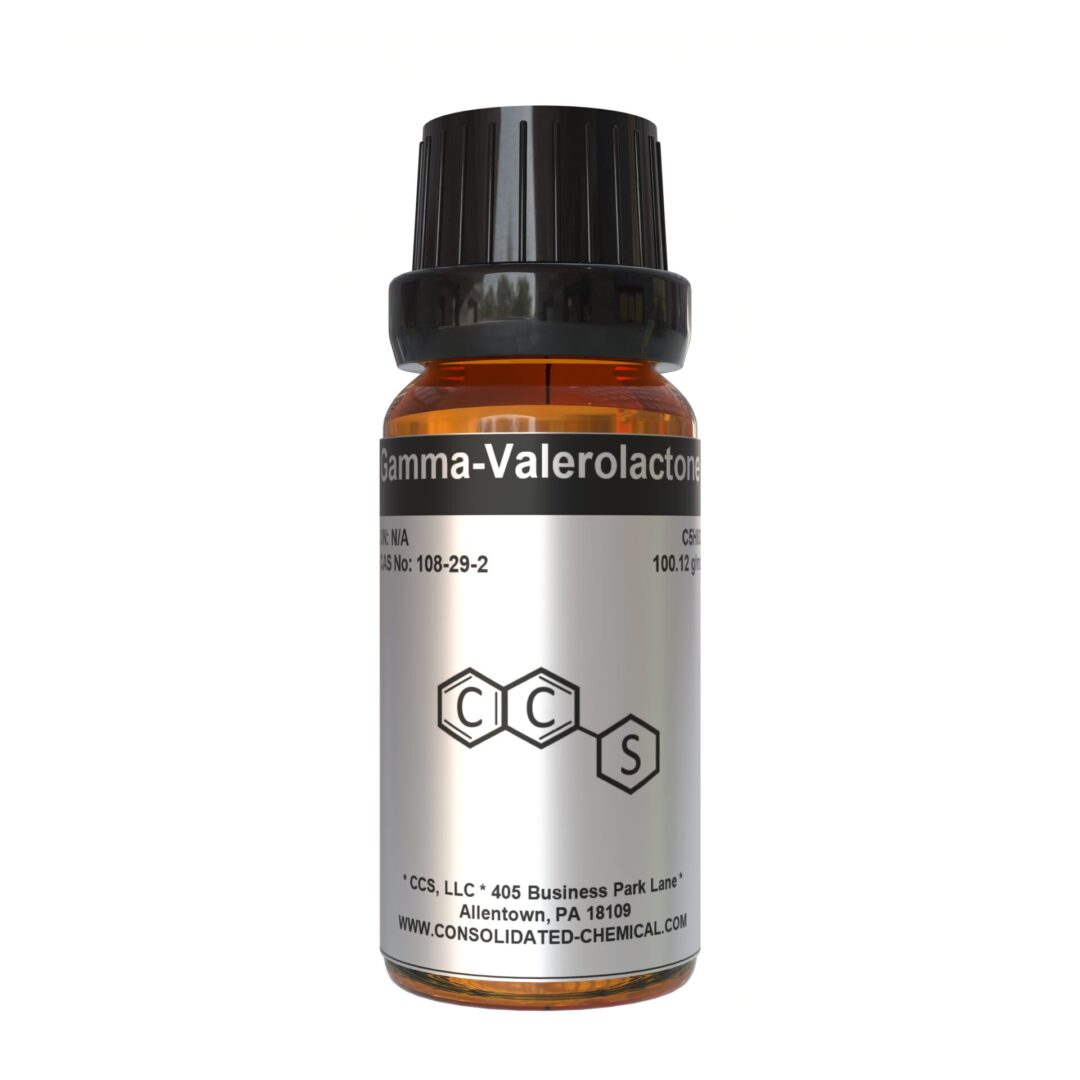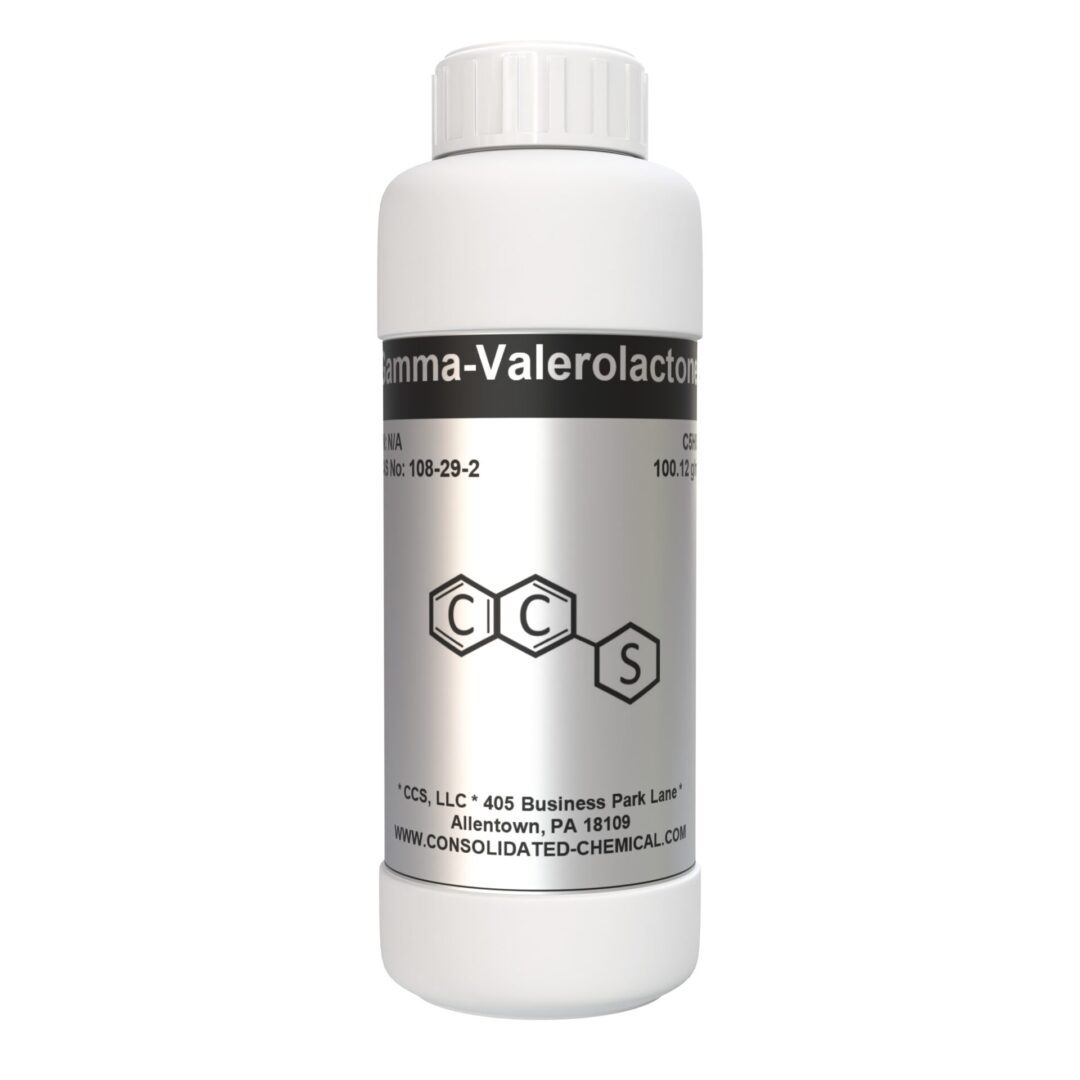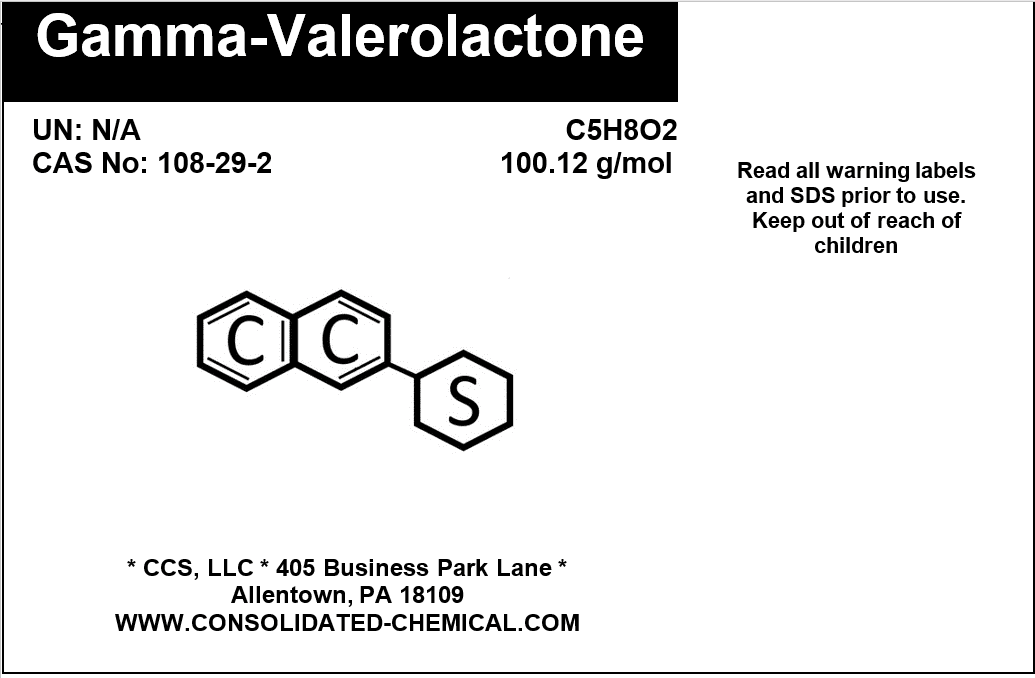Gamma Valerolactone (GVL) – Premium Bio-Based Solvent
$15.00 – $52.00
Chemical Identity
- Chemical Name: Gamma Valerolactone
- IUPAC Name: 5-Methyldihydrofuran-2(3H)-one
- CAS Number: 108-29-2
- Molecular Formula: C₅H₈O₂
- Molecular Weight: 100.12 g/mol
- EINECS Number: 203-565-6
Physical Properties
- Appearance: Clear, colorless liquid
- Odor: Mild, slightly sweet aroma
- Boiling Point: ~207°C (~405°F)
- Melting Point: -31°C (-24°F)
- Density: ~1.06 g/cm³ at 20°C
- Refractive Index: 1.436–1.438 at 20°C
- Flash Point: ~96°C (~205°F), Closed Cup
- Vapor Pressure: ~0.4 mmHg at 20°C
- Solubility: Fully miscible with water, alcohols, and most organic solvents
Chemical Properties
- Purity: ≥ 99%
- Stability: Stable under normal conditions; decomposes at high temperatures or in the presence of strong acids or bases
- Biodegradability: Readily biodegradable and environmentally friendly
Description
Gamma Valerolactone (GVL) is an innovative, sustainable solution for a variety of industrial and consumer applications. Its versatility, eco-friendly profile, and excellent solvency make it a valuable choice for modern chemical needs.
Applications of Gamma Valerolactone (GVL)
Solvent Applications
- Resins, Coatings, and Adhesives: Acts as a powerful solvent for dissolving resins, enhancing the performance of coatings, and improving adhesive formulations.
- Paints and Inks: Used in paint and ink formulations for its excellent solvency and compatibility with other components.
- Chemical Extractions: Effective in the extraction of natural compounds, such as flavors, fragrances, and pharmaceutical ingredients.
Flavor and Fragrance Industry
- Food Additive: Approved for use as a flavoring agent, imparting a mild, sweet, caramel-like taste to food and beverages.
- Perfumes and Personal Care: Enhances fragrances in perfumes, lotions, and other personal care products with its subtle sweet aroma.
Bio-Based Chemical Intermediate
- Biofuels: Serves as a precursor in the production of sustainable biofuels.
- Green Solvents: Used as a feedstock for synthesizing biodegradable and renewable solvents.
- Biodegradable Polymers: A key ingredient in the manufacture of eco-friendly polymers and materials.
Industrial Applications
- Agrochemicals: Utilized in formulations for agricultural products such as pesticides and fertilizers.
- Cleaning Agents: Incorporated into eco-friendly cleaning products for its solvency and biodegradability.
- Lubricants: Used in industrial and consumer-grade lubricants to enhance performance and sustainability.
Green Chemistry
- Sustainable Alternatives: Provides an eco-friendly replacement for petrochemical-based solvents in industrial processes.
- Catalyst Solvent: Facilitates reactions in the synthesis of fine chemicals and pharmaceuticals.
Pharmaceutical Industry
- Drug Formulations: A solvent for active pharmaceutical ingredients (APIs) in drug development and production.
- Chemical Synthesis: Acts as an intermediate in the production of various medicinal compounds.
Energy Sector
- Fuel Additive: Enhances the performance and efficiency of biofuels.
- Energy Storage: Explored for applications in next-generation energy systems and storage technologies.
Storage Guidelines
- Temperature:
- Store in a cool, dry, and well-ventilated area.
- Optimal storage temperature: 15°C to 25°C (59°F to 77°F).
- Avoid extreme heat or freezing conditions.
- Containers:
- Use tightly sealed, corrosion-resistant containers, such as glass or HDPE drums.
- Ensure containers are properly labeled to prevent misuse.
- Environment:
- Keep away from direct sunlight, open flames, or other ignition sources.
- Avoid storing near incompatible substances, such as strong oxidizers, acids, or bases.
- Shelf Life:
- When stored under recommended conditions, Gamma Valerolactone has a shelf life of at least 2 years.
Handling Guidelines
- Personal Protective Equipment (PPE):
- Wear appropriate PPE during handling:
- Gloves: Chemical-resistant gloves (e.g., nitrile or neoprene).
- Eye Protection: Safety goggles or a face shield.
- Clothing: Long-sleeved lab coat or protective clothing.
- Wear appropriate PPE during handling:
- Work Area:
- Handle in a well-ventilated space or under a fume hood to prevent vapor buildup.
- Keep the work area free of ignition sources, including static electricity.
- Precautions:
- Avoid contact with skin, eyes, or clothing.
- Do not eat, drink, or smoke while handling.
- Use explosion-proof tools and equipment in areas where vapor may be present.
- First Aid Measures:
- Inhalation: Move to fresh air and seek medical attention if symptoms occur.
- Skin Contact: Wash thoroughly with soap and water. Remove contaminated clothing.
- Eye Contact: Flush eyes with water for at least 15 minutes and seek medical attention if irritation persists.
- Ingestion: Do not induce vomiting. Rinse mouth and seek immediate medical attention.
Additional information
| Size | 30mL (1 Fl Oz), 100mL (3.3 Fl Oz), 250mL (8 Fl Oz), 500mL (16 Fl Oz) |
|---|
Related products
-
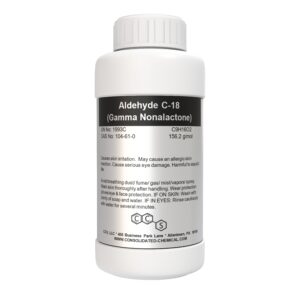
Aldehyde C-18 (Gamma Nonalactone) | Fragrance Compound
$9.99 – $42.00 Select options This product has multiple variants. The options may be chosen on the product page -
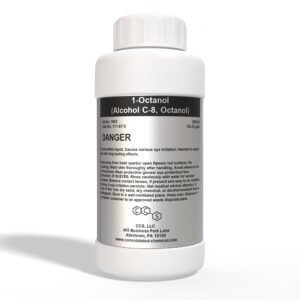
1-Octanol (Alcohol C-8) Premium Aroma Fragrance Compound
$12.00 – $95.00 Select options This product has multiple variants. The options may be chosen on the product page -

Methyl Isoeugenol – High-Quality Aroma and Flavor Ingredient – 30mL
$12.00 Add to cart -

Vanillin (Artificial Vanilla) | Premium Quality 100% Pure
$12.00 – $24.99 Select options This product has multiple variants. The options may be chosen on the product page
SKU: N/A
Categories: Flavoring Agent, Food Additive, Fragrance Chemical, Fragrances & Aromas (15), Herbicide, Pesticide, Solvents (3)
Tags: 108-29-2, bio-based solvent, biodegradable gamma valerolactone, buy gamma-valerolactone, buy gamma-valerolactone online, buy GVL, buy GVL online, CAS 108-29-2, Eco-Friendly Solvent, food-grade GVL, Gamma Valerolactone, gamma valerolactone agrochemical use, gamma valerolactone applications, gamma valerolactone bulk supplier, gamma valerolactone chemical, gamma valerolactone distributor, gamma valerolactone extraction solvent, gamma valerolactone fragrance, gamma valerolactone supplier, gamma-valerolactone advanced materials, gamma-valerolactone alternative energy, gamma-valerolactone alternative name, gamma-valerolactone alternative solvents, gamma-valerolactone analysis, gamma-valerolactone as diluent, gamma-valerolactone as extraction solvent, gamma-valerolactone as green solvent, gamma-valerolactone as plasticizer, gamma-valerolactone as precursor, gamma-valerolactone best practices, gamma-valerolactone best sources, gamma-valerolactone bio-refinery applications, gamma-valerolactone biodegradable solvent, gamma-valerolactone biopolymer applications, gamma-valerolactone biorefining, gamma-valerolactone bulk, gamma-valerolactone carbon footprint, gamma-valerolactone carbon-neutral, gamma-valerolactone CAS 108-29-2, gamma-valerolactone catalysis, gamma-valerolactone catalyst support, gamma-valerolactone chemical research, gamma-valerolactone chemical safety, gamma-valerolactone circular economy, gamma-valerolactone commercial production, gamma-valerolactone commercialization, gamma-valerolactone competitive pricing, gamma-valerolactone compliance standards, gamma-valerolactone degradation studies, gamma-valerolactone distillation, gamma-valerolactone distribution network, gamma-valerolactone drug development, gamma-valerolactone eco-certifications, gamma-valerolactone eco-friendly alternatives, gamma-valerolactone eco-friendly solutions, gamma-valerolactone economic feasibility, gamma-valerolactone emerging applications, gamma-valerolactone environmental compliance, gamma-valerolactone environmental impact, gamma-valerolactone environmental regulations, gamma-valerolactone experimental data, gamma-valerolactone food additive, gamma-valerolactone food-grade, gamma-valerolactone for agriculture, gamma-valerolactone for biodegradable plastics, gamma-valerolactone for cleaning products, gamma-valerolactone for drug formulation, gamma-valerolactone for electrochemical synthesis, gamma-valerolactone for emerging industries, gamma-valerolactone for green processes, gamma-valerolactone for polymer additives, gamma-valerolactone for polymer synthesis, gamma-valerolactone for sustainable development, gamma-valerolactone fragrance component, gamma-valerolactone fragrance ingredient, gamma-valerolactone fuel additive, gamma-valerolactone fuel cell applications, gamma-valerolactone futuristic solutions, gamma-valerolactone GCMS, gamma-valerolactone global demand, gamma-valerolactone global supply, gamma-valerolactone green chemistry, gamma-valerolactone green solvents industry, gamma-valerolactone hazard classification, gamma-valerolactone high purity, gamma-valerolactone high-performance applications, gamma-valerolactone high-performance solvents, gamma-valerolactone hydrogenation, gamma-valerolactone hydrolysis, gamma-valerolactone in adhesives, gamma-valerolactone in alternative fuels, gamma-valerolactone in biodegradable products, gamma-valerolactone in biofuels, gamma-valerolactone in biomass conversion, gamma-valerolactone in coatings, gamma-valerolactone in cosmetics, gamma-valerolactone in eco-conscious industries, gamma-valerolactone in emerging markets, gamma-valerolactone in energy storage, gamma-valerolactone in flavor industry, gamma-valerolactone in fragrances, gamma-valerolactone in hydrogen storage, gamma-valerolactone in industrial chemistry, gamma-valerolactone in lubricants, gamma-valerolactone in next-gen materials, gamma-valerolactone in personal care, gamma-valerolactone in pharmaceuticals, gamma-valerolactone in resins, gamma-valerolactone in specialty chemicals, gamma-valerolactone in surface coatings, gamma-valerolactone in sustainable agriculture, gamma-valerolactone industrial adoption, gamma-valerolactone industrial integration, gamma-valerolactone industrial uses, gamma-valerolactone industrial-grade, gamma-valerolactone industry applications, gamma-valerolactone industry benchmarks, gamma-valerolactone industry innovations, gamma-valerolactone innovative applications, gamma-valerolactone innovative uses, gamma-valerolactone lab reagent, gamma-valerolactone lactone derivatives, gamma-valerolactone lactone structure, gamma-valerolactone latest studies, gamma-valerolactone low-toxicity solvent, gamma-valerolactone manufacturer, gamma-valerolactone market forecast, gamma-valerolactone market trends, gamma-valerolactone material safety, gamma-valerolactone material science, gamma-valerolactone miscibility, gamma-valerolactone molecular formula, gamma-valerolactone molecular weight, gamma-valerolactone MSDS, gamma-valerolactone natural alternative, gamma-valerolactone natural product chemistry, gamma-valerolactone new synthesis methods, gamma-valerolactone organic reactions, gamma-valerolactone organic synthesis, gamma-valerolactone pharma-grade, gamma-valerolactone polymer precursor, gamma-valerolactone price, gamma-valerolactone processing, gamma-valerolactone product catalog, gamma-valerolactone product specifications, gamma-valerolactone production, gamma-valerolactone production technology, gamma-valerolactone properties, gamma-valerolactone purification methods, gamma-valerolactone purity, gamma-valerolactone quality assurance, gamma-valerolactone quality control, gamma-valerolactone reactive diluent, gamma-valerolactone reactivity, gamma-valerolactone regulatory compliance, gamma-valerolactone regulatory guidelines, gamma-valerolactone regulatory updates, gamma-valerolactone renewable chemicals, gamma-valerolactone renewable resource, gamma-valerolactone research developments, gamma-valerolactone research papers, gamma-valerolactone safe handling, gamma-valerolactone safety data sheet, gamma-valerolactone SDS, gamma-valerolactone shelf life, gamma-valerolactone solubility, gamma-valerolactone solvent properties, gamma-valerolactone stability, gamma-valerolactone storage, gamma-valerolactone supplier China, gamma-valerolactone supplier Europe, gamma-valerolactone supplier India, gamma-valerolactone supplier UK, gamma-valerolactone supplier USA, gamma-valerolactone surfactant applications, gamma-valerolactone sustainability focus, gamma-valerolactone sustainability roadmap, gamma-valerolactone sustainable alternatives, gamma-valerolactone sustainable manufacturing, gamma-valerolactone sustainable solvent, gamma-valerolactone synthesis, gamma-valerolactone synthesis pathways, gamma-valerolactone technical documentation, gamma-valerolactone technical grade, gamma-valerolactone technical sheet, gamma-valerolactone testing, gamma-valerolactone trade name, gamma-valerolactone transportation regulations, gamma-valerolactone upcoming applications, green chemistry solvent, GVL bulk supplier, GVL chemical, GVL chemical intermediate, GVL cleaning solvent, GVL distributor, GVL for adhesives, GVL for biofuels, GVL for coatings, GVL for flavors, GVL for lubricants, GVL for pharmaceuticals, GVL industrial use, GVL manufacturer, GVL natural solvent, GVL solvent, high-purity GVL, renewable solvent, sustainable GVL, wholesale gamma-valerolactone, γ-valerolactone


